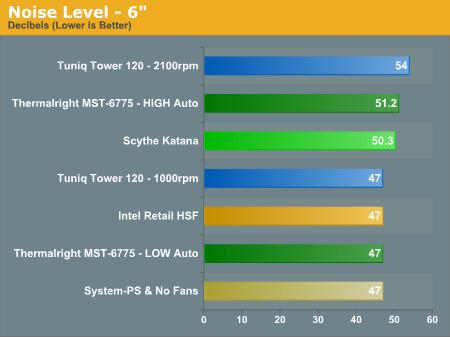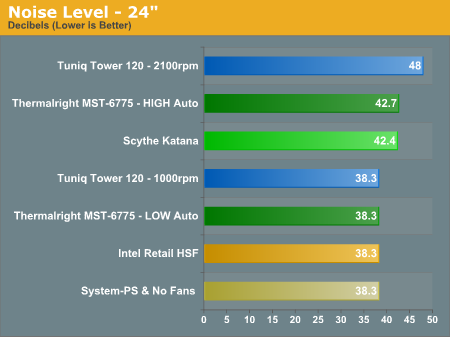Value Cooling: Two Towers for under $30
by Wesley Fink on January 23, 2007 3:50 AM EST- Posted in
- Cases/Cooling/PSUs
Noise
For some users the goal is maximum stable overclock, and they will live with the inconvenience of a louder system. For others silence is the most important factor, and these users will forgo overclocking if this increases system noise levels. Both the Thermalright MST-9775 and the Scythe Katana use 92mm fans running at a relatively slow 2000rpm to reduce noise while still maintaining high air flow for cooling. This is a particularly large fan for cooling solutions aimed at the value end of the cooler market.
In addition, the 4 pin fan connector used by the MST-9775 allows the system to automatically vary fan speed based on CPU temperature. In testing we found the variation between the Auto low and high speeds to be around 1000rpm on low and 2000rpm on high speed. As a result of the variable fan speed results at both low and high fan speeds were measured and reported for the Thermalright.
There are virtually no power supplies that do not have a fan. While Zalman and a few others do make a few expensive fanless power supplies, we are not aware of one that is larger than 500W, or that would be used for seriously overclocking a system. With that in mind the noise level of the system with all fans turned off except the Power Supply was measured. The power supply used for the cooling test bed was the OCZ PowerStream 520, which is one of the quieter high performance power supplies. The noise level of the Power Supply was 38.3db from 24" (61cm) and 47db from 6" (152mm). The measured noise level of the test room is 36.4db, which would be considered a relatively quiet room with a noise floor below the OCZ PowerStream 520 PSU.
Keep in perspective that the dB scale is logarithmic and not linear, so a 3dB increase represents a doubling of sound power. Some studies suggest that while the human ear can discern small differences in sound level, the human ear perceives a doubling of loudness at a 10dB increase. Others quote double the sound level perception as 6db.


Measured noise levels in this chart should be considered worst case. Measurements were taken with an open side of a mid tower case 6" from the HSF and 24" from the HSF. Real world would be a completely closed case with a further reduction in noise.
Subjectively the Scythe and Thermalright were both quiet at the standard fan speed of 2000rpm. However, neither cooler was really as quiet as a stock Intel HSF. The increase in noise will be hardly noticed by most users since the noise increase is small and the noise frequency is not particularly irritating.
When the Thermalright MST-9775 drops to low speed on Auto the measured noise is below the system noise floor. If minimum noise is your goal, a fan speed controller could easily be added to the Katana or the MST-9775 to keep noise levels below the system floor. We found just below top speed - about 1800rpm - dropped measured noise below the system floor.
For some users the goal is maximum stable overclock, and they will live with the inconvenience of a louder system. For others silence is the most important factor, and these users will forgo overclocking if this increases system noise levels. Both the Thermalright MST-9775 and the Scythe Katana use 92mm fans running at a relatively slow 2000rpm to reduce noise while still maintaining high air flow for cooling. This is a particularly large fan for cooling solutions aimed at the value end of the cooler market.
In addition, the 4 pin fan connector used by the MST-9775 allows the system to automatically vary fan speed based on CPU temperature. In testing we found the variation between the Auto low and high speeds to be around 1000rpm on low and 2000rpm on high speed. As a result of the variable fan speed results at both low and high fan speeds were measured and reported for the Thermalright.
There are virtually no power supplies that do not have a fan. While Zalman and a few others do make a few expensive fanless power supplies, we are not aware of one that is larger than 500W, or that would be used for seriously overclocking a system. With that in mind the noise level of the system with all fans turned off except the Power Supply was measured. The power supply used for the cooling test bed was the OCZ PowerStream 520, which is one of the quieter high performance power supplies. The noise level of the Power Supply was 38.3db from 24" (61cm) and 47db from 6" (152mm). The measured noise level of the test room is 36.4db, which would be considered a relatively quiet room with a noise floor below the OCZ PowerStream 520 PSU.
Keep in perspective that the dB scale is logarithmic and not linear, so a 3dB increase represents a doubling of sound power. Some studies suggest that while the human ear can discern small differences in sound level, the human ear perceives a doubling of loudness at a 10dB increase. Others quote double the sound level perception as 6db.


Measured noise levels in this chart should be considered worst case. Measurements were taken with an open side of a mid tower case 6" from the HSF and 24" from the HSF. Real world would be a completely closed case with a further reduction in noise.
Subjectively the Scythe and Thermalright were both quiet at the standard fan speed of 2000rpm. However, neither cooler was really as quiet as a stock Intel HSF. The increase in noise will be hardly noticed by most users since the noise increase is small and the noise frequency is not particularly irritating.
When the Thermalright MST-9775 drops to low speed on Auto the measured noise is below the system noise floor. If minimum noise is your goal, a fan speed controller could easily be added to the Katana or the MST-9775 to keep noise levels below the system floor. We found just below top speed - about 1800rpm - dropped measured noise below the system floor.










28 Comments
View All Comments
orangesky - Tuesday, January 23, 2007 - link
Since the Thermalright fan blows down towards the motherboard (as does Intel's stock HSF), but the Katana blows across (and out of the case), it seems like there would be a noticable air flow difference on the components around the CPU (e.g., VRM, memory, and NB).Was there any difference noted in the temperature of the "motherboard" (which probably is the NB)? I'm wondering if this is a concern or not, especially for OC'ing?
Spacecomber - Tuesday, January 23, 2007 - link
For coolers, like the Katana, which lack 4-wire connectors that 775 motherboards can automatically adjust fan speeds via, perhaps it would be helpful to take advantage of speedfan for comparing cooling across a range of fan speeds. (This is assuming that the relatively new 680i motherboard that you are using is supported by SpeedFan.)Doh! - Tuesday, January 23, 2007 - link
A new version of Katana has a 4-wire connector. I just bought one last week. The box has 775 written on it and does not come with a back plate.Wesley Fink - Tuesday, January 23, 2007 - link
Scythe has introduced another version of the Katana called the Katana 775. This was to address the installation and fan speed issues we discussed. The Katana 775 only fits Socket 775 and it comes with a 4-pin fan header. The original Katana, with universal installation as we reviewed here, continues as a current product.If you are only concerned with Socket 775 the Scythe Katana 775 looks lik a much better choice with easier installation and fan speed control at the same price or less than the original Katana.
KorruptioN - Tuesday, January 23, 2007 - link
For under $30, I think the Arctic Cooling Freezer 7 Pro should've been included. Quiet, not so heavy, with very good performance for the money.Wesley Fink - Tuesday, January 23, 2007 - link
We are not finished with coolers under $30, and we will try to include the Arctic Cooling Freezer 7 Pro in our upcoming value cooler roundup. The Freezer 7 Pro also uses a 92mm fan, but it weighs a bit more than this pair at 520g (vs. 300g and 420g).mostlyprudent - Tuesday, January 23, 2007 - link
I notice in the noise charts that the Retail HSF is only listed once. Is this at its idle speed? I may have missed it in the review, but what is the RPM range of the retail HSF?BTW, nice article.
Wesley Fink - Tuesday, January 23, 2007 - link
The Intel Retail HSF was below the system noise floor at both high and low speeds. We will try to make this clearer in future reviews.